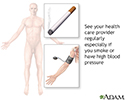Physical exam frequency
How often you need a physical exam; Health maintenance visit; Health screening; Checkup
Information
All adults should visit their health care provider from time to time, even if they are healthy. The purpose of these visits is to:
- Screen for diseases
- Assess risk of future medical problems
- Encourage a healthy lifestyle
- Update vaccinations
- Maintain a relationship with a provider in case of an illness
For recommendations for men and women by age group, see:
-
Health screening -- women -- age 18 to 39
Health screening -- women -- age 18 to ...
You should visit your health care provider from time to time, even if you are healthy. The purpose of these visits is to:Screen for medical issuesAs...
Read Article Now Book Mark Article -
Health screening -- women -- age 40 to 64
Health screening -- women -- age 40 to ...
You should visit your health care provider from time to time, even if you are healthy. The purpose of these visits is to:Screen for medical issuesAs...
 ImageRead Article Now Book Mark Article
ImageRead Article Now Book Mark Article -
Health screening -- women -- over 65
Health screening -- women -- over 65
You should visit your health care provider from time to time, even if you are healthy. The purpose of these visits is to:Screen for medical issuesAs...
 ImageRead Article Now Book Mark Article
ImageRead Article Now Book Mark Article -
Health screening -- men -- age 18 to 39
Health screening -- men -- age 18 to 39
You should visit your health care provider regularly, even if you feel healthy. The purpose of these visits is to:Screen for medical issuesAssess yo...
Read Article Now Book Mark Article -
Health screening -- men -- age 40 to 64
Health screening -- men -- age 40 to 64
You should visit your health care provider regularly, even if you feel healthy. The purpose of these visits is to:Screen for medical issuesAssess yo...
 ImageRead Article Now Book Mark Article
ImageRead Article Now Book Mark Article -
Health screening -- men -- over 65
Health screening -- men -- over 65
You should visit your health care provider regularly, even if you feel healthy. The purpose of these visits is to:Screen for medical issuesAssess yo...
 ImageRead Article Now Book Mark Article
ImageRead Article Now Book Mark Article
References
Atkins D, Barton M. The periodic health examination. In: Goldman L, Schafer AI, eds. Goldman's Cecil Medicine . 25th ed. Philadelphia, PA: Elsevier Saunders; 2016:chap 15.
-
Blood pressure check - illustration
To measure blood pressure, your doctor uses an instrument call a sphygmomanometer, which is more often referred to as a blood pressure cuff. The cuff is wrapped around your upper arm and inflated to stop the flow of blood in your artery. As the cuff is slowly deflated, your doctor uses a stethoscope to listen to the blood pumping through the artery. These pumping sounds register on a gauge attached to the cuff. The first pumping sound your doctor hears is recorded as the systolic pressure, and the last sound is the diastolic pressure.
Blood pressure check
illustration
-
Physical exam frequency - illustration
Even if you feel fine, it still important to see your health care provider regularly to check for potential problems. Certain symptoms such as high blood sugar and high cholesterol levels often do not produce any symptoms until advanced disease has occurred.
Physical exam frequency
illustration
-
Blood pressure check - illustration
To measure blood pressure, your doctor uses an instrument call a sphygmomanometer, which is more often referred to as a blood pressure cuff. The cuff is wrapped around your upper arm and inflated to stop the flow of blood in your artery. As the cuff is slowly deflated, your doctor uses a stethoscope to listen to the blood pumping through the artery. These pumping sounds register on a gauge attached to the cuff. The first pumping sound your doctor hears is recorded as the systolic pressure, and the last sound is the diastolic pressure.
Blood pressure check
illustration
-
Physical exam frequency - illustration
Even if you feel fine, it still important to see your health care provider regularly to check for potential problems. Certain symptoms such as high blood sugar and high cholesterol levels often do not produce any symptoms until advanced disease has occurred.
Physical exam frequency
illustration
Review Date: 4/11/2015
Reviewed By: Linda J. Vorvick, MD, Medical Director and Director of Didactic Curriculum, MEDEX Northwest Division of Physician Assistant Studies, Department of Family Medicine, UW Medicine, School of Medicine, University of Washington, Seattle, WA. Internal review and update on 07/24/2016 by David Zieve, MD, MHA, Isla Ogilvie, PhD, and the A.D.A.M. Editorial team.



